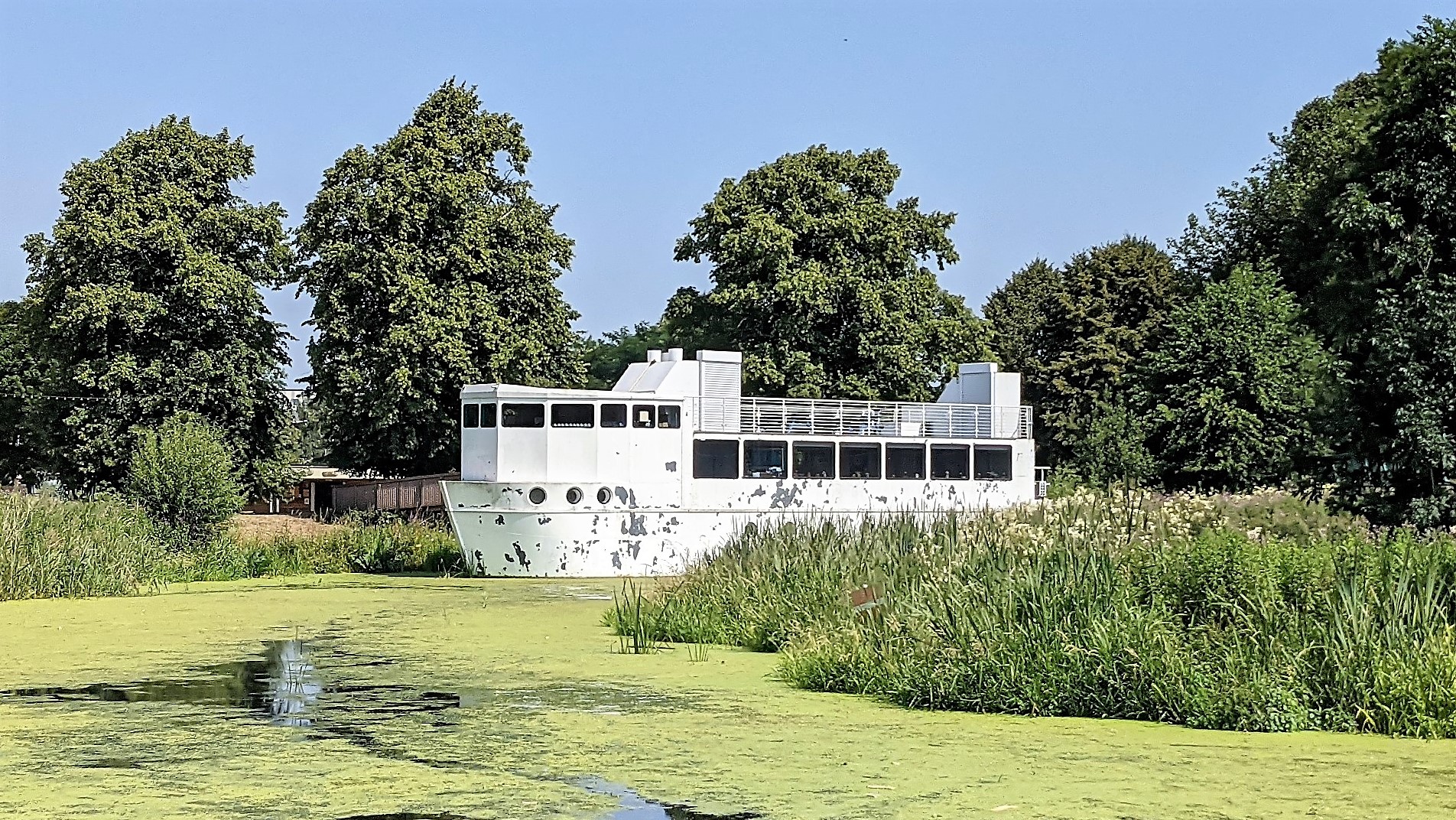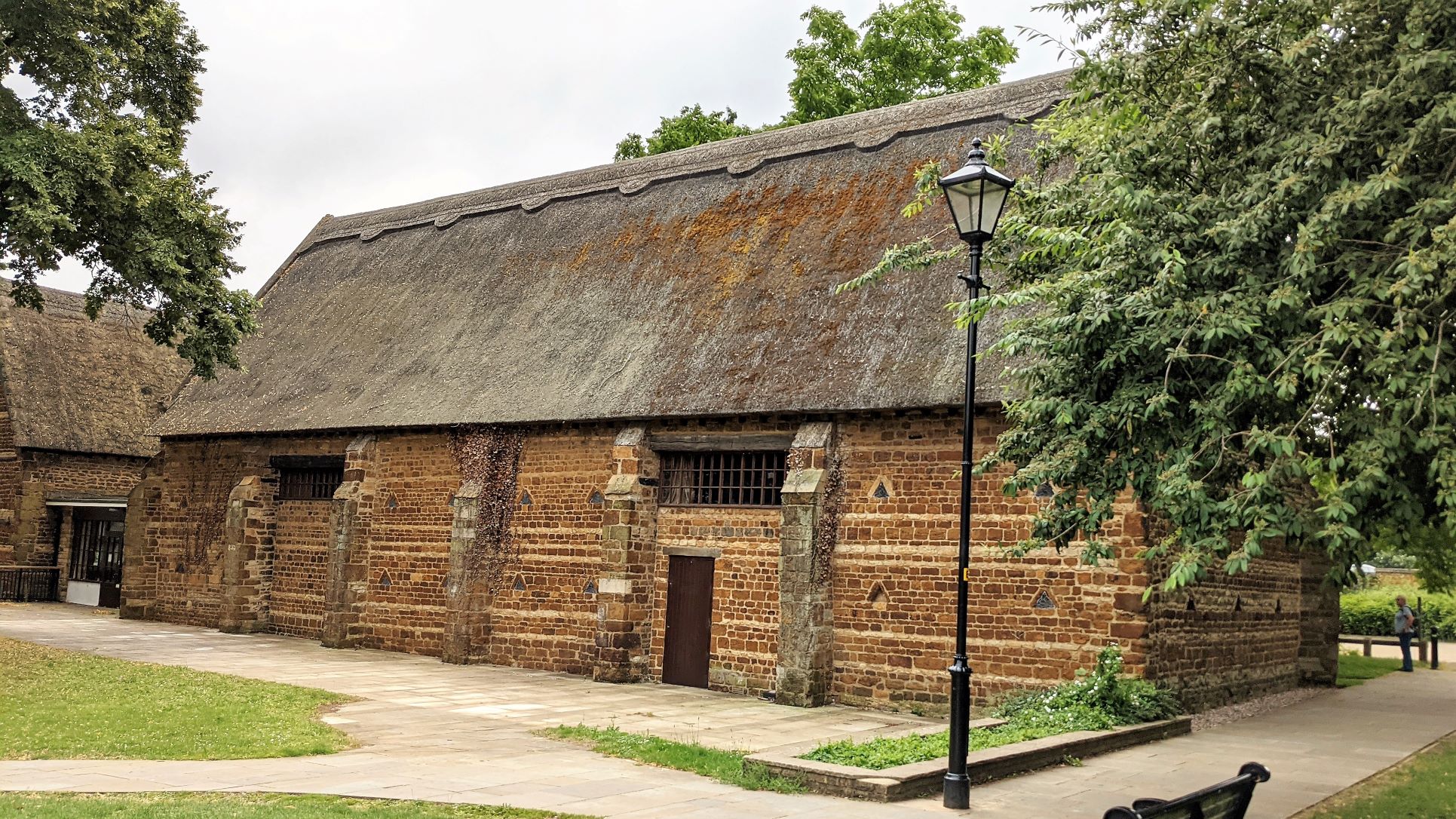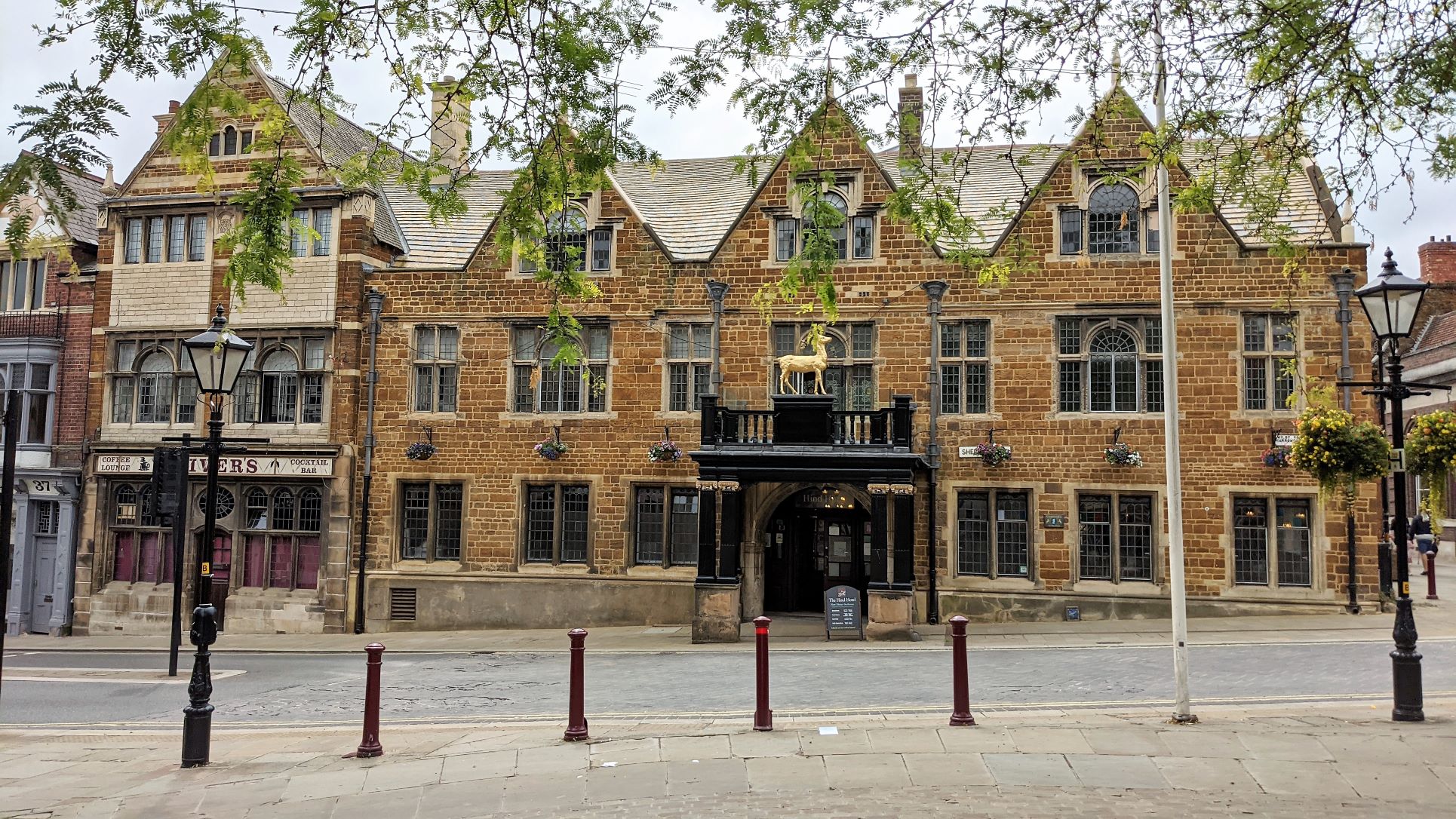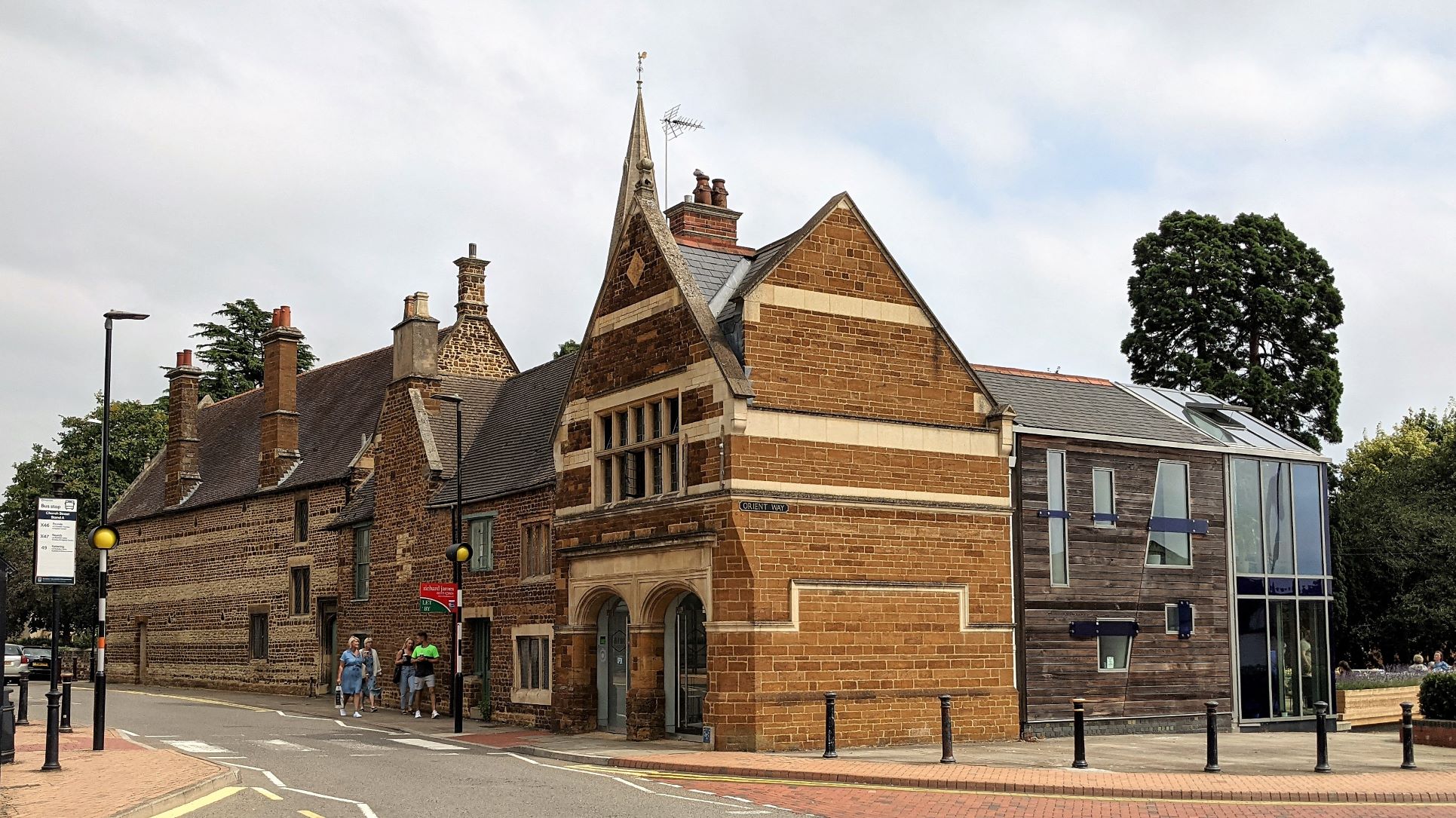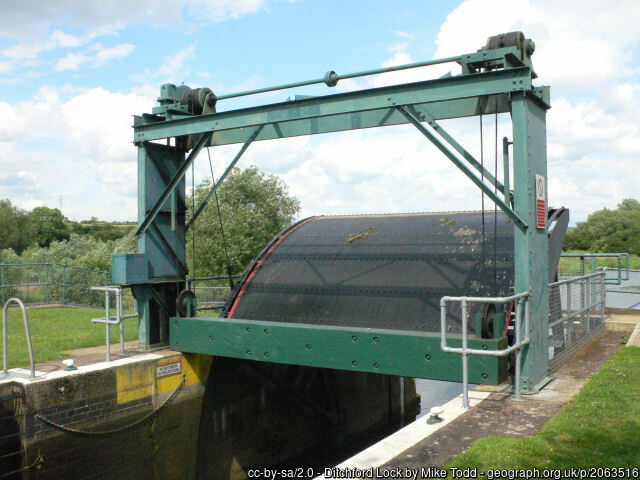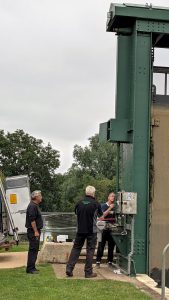Onto The River Nene
After a week of travelling and weddings, with a strong theme of eating and drinking, we found ourselves back on the boat in Northampton Marina before noon on Monday and we set about preparing to finally head off down the river. The weather was still very hot and sunny, as it was for the wedding, which made our preparations harder work, so we rather had to force ourselves to get things done.
We stocked up at Morrison's, a few hundred yards from the marina, in the afternoon. We also unearthed and set up the anchor, as required for journeys on rivers that might be subject to strong streams and wayward currents. We would have to be working around this great lump of metal and the associated fathoms of metal chain and rope, sitting in the well deck, for many weeks to come.
Tuesday morning kicked off just as hot and sunny and we got going, out of the marina, perversely heading west and having to turn back through a hundred and eighty degrees around the sluice sited between the marina and the lock.
There were two guys from the Environment Agency working around the lock with some fancy camera gear. We asked them what they were doing and they explained they were placing black and white sight markers on key parts of the structures to capture them for some form of laser modelling, which would be used to plan future maintenance with much greater detail and accuracy. After that we began to recognise these markers everywhere on our way down the river.
Technically, we were on the Nene once we came through Cotton End Lock last week but going Northampton Lock really marked the change for us. The lock was quite a different construction and as we set off from the bottom you started to get the river feel. Closed in banks with no towpath and lined with reeds and undergrowth. At this point it isn't that wide but there is none of the regularity of most canals and odd channels and wider stretches appear all the time. We also saw a boat moored off to our left that made it clear we were no longer on the narrow canals.
It was another hot, sunny day and we had decided to set off with the pram hood still up as there were no height restrictions identified on our route today. We were only round the second bend when I suddenly began to doubt that we were going to fit under the road bridge we were fast approaching. I slowed down to have a better look and quickly went into full reverse, just in time to come to a halt with forty feet of the boat underneath the bridge. Luckily it was flat calm and there was no real current yet so were able to hold station there while we scrambled to get the hood down enough to get through it. We decided we probably wouldn't be trying that again!
For today we planned to go as far as Weston Flavell Lock where there was supposed to be an EA mooring just upstream. The river locks were longer than we are used to on the canals and wider although, at thirteen feet, not quite double width. The first three locks were conventional enough in operation, with double gates and paddles at each end. Weston Flavell Lock, itself, would be the first of the guillotine locks that are mostly featured on the river. The upstream gates are mitred double gates in the usual way but the downstream end is a vertical gate that is raised and lowered with an electric motor. You need a specific EA "Abloy" key, which in our case we had purchased at Northampton Marina, to access the control cabinet. All new to us so we wanted to check it out that evening before going through the next day.
Sharing one of the locks with "Annie", we found ourselves in an unacknowledged race to the mooring as they told us they had decided they intended to moor there too. We got away first and made full use of the dizzying six mile an hour speed limit to maintain our lead. In the event, there was no need to worry. The mooring was there just as expected, a nicely constructed pontoon with proper black and white mooring bollards along it, wholly unoccupied and long enough to accommodate three narrowboats at least.
Weston Flavell & The Washlands
It was very hot by now and there was no shade on the mooring pontoon as it sits in a wide, flat landscape of channels and storage lakes, surrounded by tall embankments. This makes up the Northampton Washlands Scheme which protects development to the east of Northampton and in times of flood can hold up to five hundred million gallons of water. Near Abington Lock upstream and at Weston Flavell Lock at the downstream end, there are huge barrage gates that are lowered to contain the flood waters, apparently accompanied by lights and sirens to warn approaching vessels to stand clear.
Despite the heat I decided to go for a walk around this area, back as far as Abington Lock and up to Great Houghton to the east. The first part was certainly rather a slog in the burning sun, being very flat and featureless, although it has become quite a nature reserve. There followed a bit of a trek through a big industrial estate before climbing back out into the countryside. Arriving in Great Houghton, via an amusingly named lane.
I was rather disappointed to find the White Hart firmly closed but my route happened to also take me past the Old Cherry Tree. They were open, very welcoming and happy to dispense a pint of orange juice and lemonade, stacked with ice, for a very reasonable charge of £2.00. It really was greatly needed by then.
Returning to the boat I passed twenty or so teenagers, happily ignoring the no swimming, no jumping, no diving signs displayed around the huge structures intended to manage the water flows. Sue & I went over to have a look at the mechanism for the lock, which seemed pretty straightforward and only just made it back to the boat before a brief, torrential thunderstorm came in to clear the air.
Day Two - Back In A Marina
There was no fuel available at Northampton Marina so we decided to book into White Mills Marina for the next night, get some diesel there and sort out a few things we needed to resolve for the trip ahead, including joining Friends Of The River Nene. For the princely sum of twelve pounds per annum, membership entitles you to moor at any of the 48 hour mooring sites they have established along the river. These have no facilities, as such and they are often quite isolated but they are kept clear of vegetation, have permission in place with the landowner and will normally have the river bed dug out up to a straight bank, more or less. As usual, being sure of being able to find somewhere to moor is one of the main issues with river cruising.
It was less than five miles but took us through five locks on the way. These certainly are different to the familiar canal locks. At the upstream end there are double gates, mitred against the flow and made of steel. They have gate paddles, operated with a windlass, that generally seem to move quite easily. At the downstream end there are the massive steel structures that hold the guillotine gate and a counterweight, connected by what looks like a giant bicycle chain.
An electric motor drives the heavy gate up or down when the boater presses the button on the control panel. When the gate is raised it lifts a short distance and there is then a delay while the lock empties before you can continue raising the gate. While there is no effort involved in pushing the button, of course, the gates move extremely slowly and only while the button is pressed. It is amazing how tiring it is to be standing with your finger pressing a button for five minutes at a time.
White Mills Marina was very nice and welcoming, although Covid-19 pings had shut their very popular Boathouse café for the foreseeable future. This was also where we heard the Wadenhoe Lock, a few miles downstream, had been broken and impassable for over a week. Parts were being fabricated and there was some expectation that it might be open by the weekend but no certainty. We realised then that not only did we need to take our time getting to that lock but that there was a risk that moorings either side of it for a few miles would now be clogged with boats marooned by the stoppage.
It was still hot and sunny but we managed a nice circular walk along the river and back through Earl's Barton, which was quite a sizeable place about a mile away by the direct route. It has lots of shops, pubs etc. and quite an attractive centre. I rather liked this unusual shop on the crossroads.
We were also able to get a refreshing pint in The Old Swan there, before heading back to the boat.
Hardwater Mill
We had a very short hop the next day and sampled a "Friends" site at Hardwater Mill. The moorings are marked with green, Friends Of The River Nene signs at each end and consist of a length of bank that has been cleared of vegetation and had the bank and river bed dug out where necessary to be straight and deep enough. In some cases we found they hadn't necessarily stayed either straight or deep so you needed to pick your spot whenever you used one of these sites.
This was a delightful spot, though and seemed, at first, to be very remote. In fact, we were already starting to realise that you are never alone in Northamptonshire. The Nene Valley Way runs along behind the mooring and there were ramblers and anglers, dog walkers and picnickers passing along quite often. Down by the mill itself was a car park that attracted several groups to swim and play in the mill pond, with the attendant squeals, music and barbecues. Luckily, just too far away to be able to hear them from the boat.
We set out to walk up to Great Doddington and again, around every corner, you would find others out enjoying the countryside. Not a problem but this has not been our experience in decades of walking country footpaths in England. Normally, once you leave the immediate environs of a town or village, you don't see a soul. Perhaps it is an effect of the pandemic or a hangover from lockdown exercise rules, rather than a peculiarity of Northamptonshire, as such.
The mill has been there for over a thousand years and is said to have been a stopover for Thomas A Becket following his escape from Northampton Gaol. It is now self-catering accommodation owned by the occupants of the adjacent mill cottage. Passing the revellers in the mill pond we saw the Archimedes screw they have installed to generate electricity from the force of what was, presumably, the old mill race.
Unfortunately, as well as meeting the electrical needs of the site and feeding excess on to the National Grid, this is also the source of a constant, loud, regular thumping noise as it turns. You wouldn't want to stay there if you were a light sleeper.
Great Doddington sits high up on the hillside to the north of the river and the view from the village is probably one of the best things about it. People whose gardens overlook the valley must have fantastic views. Our best sight of it was at the top of the climb just before we entered Great Doddington itself.
As we sat in the garden of the Stag's Head we watched an old biplane flying overhead and looping the loop over the valley. When we got back to the boat we had been joined by another narrowboat, "Sumaka". Speaking to the owner, it turned out that he used to have a pilot's license and he told us there were three Tiger Moths based at nearby Sywell. Presumably, our flying display was one of those.
Having begun to settle down later that evening, with darkness falling fast and looking out at the peace and silence, we became aware of a light in the distance and the sound of an approaching engine. At White Mills Marina we had been on the next berth to a forty four foot narrowboat called "Wild Lavender" that had clearly recently been part of the hire fleet from Calcutt Boats, near our home in Warwickshire. It now belonged to a firm called Solitude Holidays and appeared to be their only vessel for hire. This was the boat that now came haring out of the gloaming, headlight blazing and piled into the bank between us and "Sumaka". The crew appeared to be a family of four; parents with two teenage sons. Everything seemed to be done by the father and at breakneck speed. Leaping onto the bank, hauling the boat in as far as he could (although he now discovered what we already knew - that there was a shoal forming at that point and it was very shallow), banging in pins and flinging out the gangplank to bridge the rather large gap. We feared the worst for the tranquillity of the spot but they seemed to settle down just as quickly as they had arrived. They disappeared inside and we heard no more from them that night.
Wellingborough
Another hot, sunny morning on Friday. "Wild Lavender" was up and off with the same sense of urgency at about eight o'clock in the morning but surprised us by coming back past us again an hour later. We stayed at Hardwater for the morning and gave the boat a wash before heading down three more locks to Wellingborough. Just before we left who should come flying past again but "Wild Lavender", this time with no sign of the two boys. Had their holiday come to a sticky end already?
We moored up at Wellingborough embankment in the afternoon. The park there was teeming with people in the sunshine and the little water park they run at the far end was full of children splashing about and having a great time. A large Tesco store just across the park was convenient for us but the closure of the EA sanitary facilities there was less so. I spoke to the man responsible for this stretch of the river and he confirmed it had been out of action for two months. The waste has to be pumped from the riverside to the nearest mains drainage, inappropriate waste had been introduced and broken the pump beyond repair and they were unable to source a replacement from Germany. He did have good news in that Wadenhoe Lock had now been repaired and was open for navigation.
It was supposed to be wet the next morning so we planned to stay on the boat and make a more detailed schedule for our trip ahead, with planned stops for overnight mooring and services etc. There was a short shower, perfectly timed as I was fetching the bacon and egg rolls from the van stationed in the car park but that was about it. We stuck diligently to our task until midday and then went out into the weak sunshine to go up into the town.
The town has a history but does nothing to promote it and makes very little of the historic buildings that have survived. Overall, we found the whole place thoroughly run down and depressing. We kept expecting to turn a corner and find the nice part of Wellingborough but in the end it couldn't escape comparison with Croydon. We followed a trail downloaded the internet which did take in some interesting sites like the old Tithe Barn, which is owned by the council but now just let out for functions and The Hind, opposite Market Street which seems to have had a facelift.
This was an interesting building backing onto the Church close. We couldn't find much about the original building but the extension on the back seems quite a marmite affair. It is now a coffee shop called Ugly Mug, which might seem appropriate but actually it did seem to blend together quite well.
Sunday morning was grey and cool with moisture in the air. There were very few people around in the park, the catering truck that had been so busy on the last two days didn't turn up, the park facilities remained resolutely closed and the area felt quite different. It was hard to understand why this should be the case on a Sunday, even if it was a bit grey. It was still the weekend, wasn't it? One small boat arrived and moored up in front of us. A couple emerged and set on a picnic bench drinking cans of Guinness; not a crime but unusual at ten o'clock in the morning, they were friendly enough though. For us, it was definitely time to leave.
A Lucky 'Break'
Leaving Wellingborough behind we headed off through Lower Wellingborough Lock. We stopped at Ditchford Lock beside the Glebe Meadow 'Farm Shop', which turned out to a single portacabin adjacent to a handful of permanent moorings. We were able to use their Elsan facility at a cost of three pounds. It was rudimentary, at best but money well spent for the peace of mind since the EA facilities at Wellingborough had been unavailable.
Ditchford Lock was also unique in having a radial gate instead of the guillotine gates we had been getting used to. It is still suspended from a frame above the downstream end of the lock and is electrically operated but is a curved metal scoop that rotates into position to hold or release the water in the lock instead of the steel blade that is raised and lowered vertically.
Before the next lock, just through a bridge, there was an EA mooring nicely laid out and it had once had services associated with it at the Leisure Centre next door. We considered stopping there for the night but the facilities were clearly a thing of the past and with Irthlingborough Lock in sight from there we decided to press on through the lock to a 'Friends' site about a mile further on. This turned out to be a very good decision. Arriving at the lock we found a cluster of concerned looking people and a couple of EA vans. The owner of another Aintree boat, "Heart Of Oak", had arrived below the lock a couple of hours earlier and gave us a run down. The lock was broken and the issue was not with the electric motor but the gearbox that it drove. The cogs that should engage to turn a vertical rod to raise the gate were stripped. There was no spare in the EA stores and no likelihood of being able to get one, certainly not on a Sunday. Meanwhile, there was one boat stuck inside the lock on the way down, with one narrowboat and two cruisers at the bottom waiting to come up.
After a bit more head scratching and wondering whether a different type of gearbox they did have in the store would fit (it wouldn't) one of the EA guys rummaged in his van and came up with a huge monkey wrench. Clamping this around the rod that should normally be driven by the motor, he was able to slowly crank the gate up. Things went a bit faster when a colleague joined him with a second wrench and they released the trapped boat. This was heavy work and clearly not a sustainable solution to keeping the lock open. However, after a brief discussion, they agreed to let "Heart Of Oak" in at the bottom to get her through. With a bit more special pleading we were also able to persuade them to work their magic one more time to let us down, after which they would be shutting the lock completely. The two cruisers were only out for the weekend so couldn't afford to go through and get stuck anyway so they chose to turn round and go back to their mooring.
Altogether, we were incredibly lucky. Had we stopped at the EA mooring just before we would have been stuck there with no access to water or other services. As it was, we not only scraped through but were only delayed for an hour or so and were moored up at Stanwick Lakes by four o'clock. After that, the lock remained closed for at least another two weeks. CRT get a lot of flack for failures to both structures and facilities. I suppose that we had expected a fully funded government department would be able maintain their relatively recent estate much better than a charity caring for a couple of hundred years of neglected heritage. The evidence to date is that they are at least as bad and take longer to resolve problems when they occur.



